LAB REPORT
Science and Technology Making Headlines
May 14, 2021

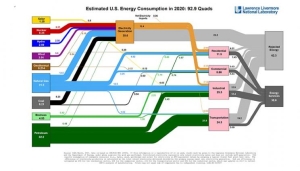
Americans used 7 percent less energy in 2020 due in part to the COVID-19 pandemic.
Dipping down
Energy use fell 7 percent in 2020 due in part to the COVID-19 pandemic.
Researchers and analysts at Lawrence Livermore National Laboratory (LLNL) released its latest annual flow chart that tracks the production and consumption of energy in the U.S. Overall, the U.S. used 92.9 quads of energy in 2020, a drop of 7.2 quads (7 percent) over the year before.
A quad is a quadrillion BTUs, and 3,412 BTUs is equivalent to a kilowatt hour. The highest recorded energy use in American history was in 2018, when 101.2 quads were consumed.
Despite the large drop in energy use, wind and solar power saw significant gains, with solar up by 19 percent and wind up 10 percent.
“Solar and wind continue to show year-on-year growth, which is an impressive change for the energy system,” says A.J. Simon, group leader for Energy at LLNL. “During the pandemic, where total electricity declined only slightly, a lot of coal generation was replaced by renewable energy.”
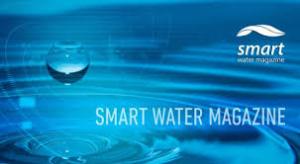
LLNL researchers have found a natural way to clean up groundwater contaminated with uranium.
It’s only natural
Uranium contamination of soils and groundwater in the United States represents a significant health risk and will require multiple remediation approaches.
Remediation strategies for uranium-contaminated sites have been the focus of research for decades due to the former production of nuclear materials across the United States. The U.S. Environmental Protection Agency (EPA) has set the drinking water standard for uranium at 0.03 parts per million (ppm). Yet most bioremediation studies are rarely conducted at uranium concentrations this low.
In a new study by Lawrence Livermore scientists, the team showed that uranium-phosphate minerals do not form abiotically in solution when concentrations are less than 0.25 ppm and pH is less than 5, in contrast to previous studies conducted at higher concentrations. Instead, they found that bacteria present in soils and sediments can facilitate the precipitation of uranium-phosphate minerals that do not precipitate abiotically.
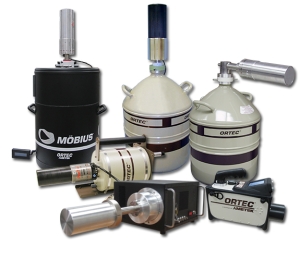
LLNL researchers developed RadScout for homeland security and weapons of mass destruction detection.
I spy radiation
With homeland security and weapons of mass destruction in the headlines, Lawrence Livermore National Laboratory and Ortec Products have teamed up to provide some protection and peace of mind.
Ortec will incorporate LLNL's RadScout technology in its Detective and Detective-EX line of portable radiation detectors and analyzers, which will be marketed within a year.
Weighing just 20 pounds, the RadScout features a miniaturized refrigeration system that cools to −280°F. This eliminates liquid nitrogen cooling for the device's germanium crystal. RadScout works by measuring neutrons and gamma rays emitted by radioactive materials. It then analyzes them to identify their sources. Researchers have designed the device so workers and emergency personnel can use it with minimal training.

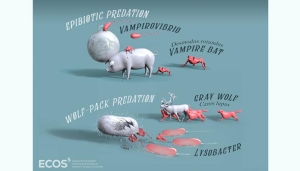
Predatory bacteria use approaches remarkably similar to much larger organisms as they target their prey. In the case of Vampirovibrio, the bacterium attaches to the outside of a prey cell and feeds on its interior cytosol — much as a vampire bat sucks blood from mammals it feeds on. For bacteria in the genus Lysobacter, several bacterial cells act as a group to hunt their prey, just as a wolf pack might target an elk. Image courtesy of Northern Arizona University.
Biting down on their kin
Predatory bacteria — bacteria that eat other bacteria — grow faster and consume more resources than non-predators in the same soil, according to a new study from Lawrence Livermore and Northern Arizona University.
These active predators, which use wolfpack-like behavior, enzymes and cytoskeletal "fangs" to hunt and feast on other bacteria, wield important power in determining where soil nutrients go. The results of the study show predation is an important dynamic in the wild microbial realm, and suggest that these predators play an outsized role in how elements are stored in or released from soil.
Like every other life form on Earth, bacteria belong to intricate food webs in which organisms are connected to one another by whom they consume and how. In macro webs, ecologists have long understood that when resources like grass and shrubs are added to lower levels of the web, predators at the top, such as wolves, often benefit. The research team wanted to test whether the same was true in the microbial food webs found in wild soil.

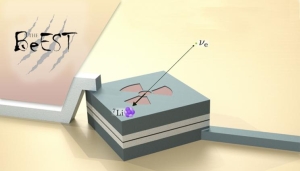
Schematic of the “BeEST” experiment. Radioactive beryllium-7 is implanted into the superconducting sensor. Precision measurements of the decay products could indicate the presence of hypothesized sterile neutrinos.
Opening the door to the dark side
Hypothetical sterile neutrinos can be detected with quantum sensors and confirm that they are the particles that make up dark matter, according to new research by Lawrence Livermore scientists.
Neutrinos are very particular subatomic particles: they have mass, but very small and difficult to measure. They are surprising because the mass they contain is not contemplated in the Standard Model that describes the subatomic world.
The sterile neutrino has not been experimentally verified, but scientists have detected clear indications of its presence and believe that the Standard Model must be expanded to accommodate its existence.
The Standard Model of particle physics is one of the most important developments in science, but many scientists believe that its current limits must be transcended to develop a more complete description of the universe.





